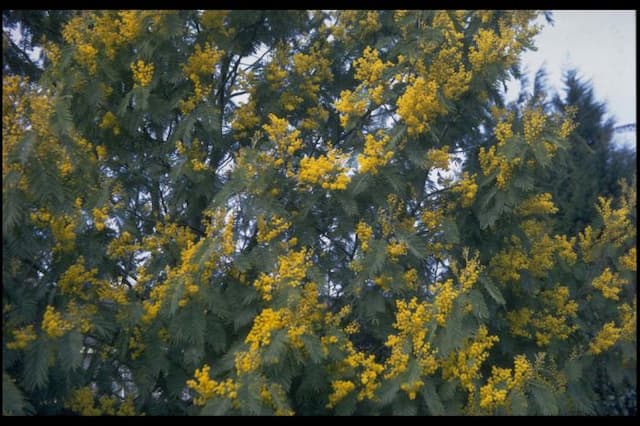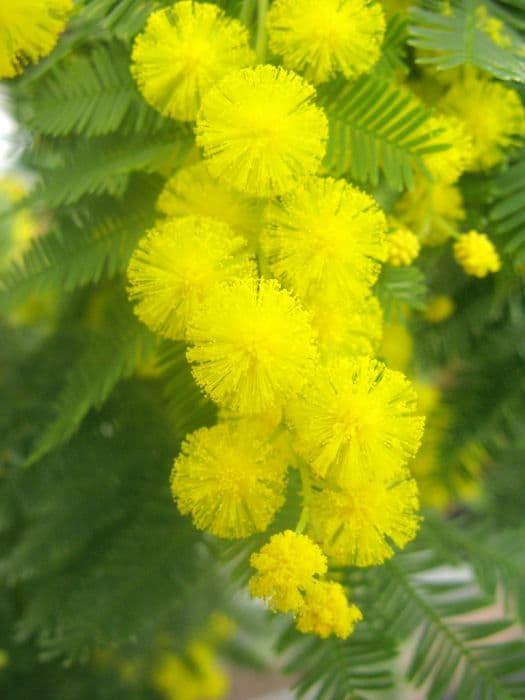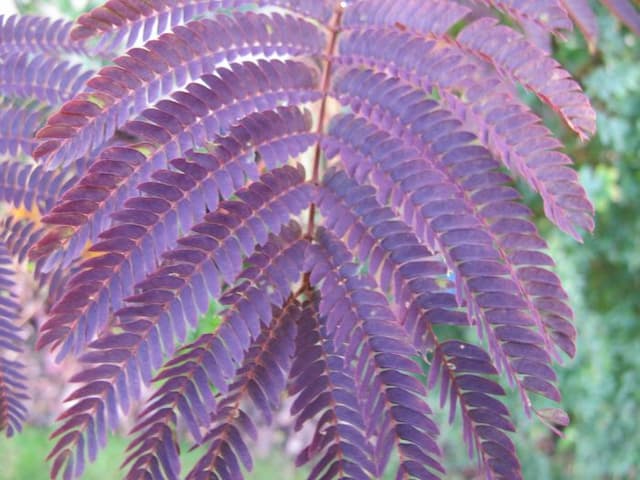Chinese Thermopsis Thermopsis chinensis

ABOUT
Thermopsis chinensis, also known as Chinese thermopsis, is a perennial plant notable for its attractive appearance. It features a lush clump of trifoliate leaves, meaning each leaf comprises three leaflets. These leaflets are broadly lance-shaped and typically have a rich green color that can stand out in a garden setting. During the blooming season, Chinese thermopsis produces eye-catching flower spikes that rise above the foliage. The spikes bear a profusion of yellow pea-like flowers. These blooms are bright and are held aloft on sturdy, upright stems. The blossoms give the plant a vibrant look and can attract various pollinators such as bees and butterflies. The plant's general appearance is quite bushy and full, making it an ideal choice for borders, meadows, or as part of a mixed perennial garden. The contrasting rich green foliage and the sunny yellow flowers create a striking visual display during the flowering period. After the blooming season, Chinese thermopsis may produce slender, elongated seed pods. These pods add another element of texture and interest to the plant's appearance, especially when they mature and dry on the plant. The overall look of Chinese thermopsis with its combination of foliage, flowers, and pods provides an extended period of visual interest throughout the growing season.
About this plant
 Names
NamesFamily
Fabaceae
Synonyms
Chinese Thermopsis, False Lupin, East Asian Bush Pea, Pea-Like Thermopsis
Common names
Baptisia floribunda, Piptanthus chinensis, Sophora davidii, Thermopsis fabacea, Thermopsis lupinoides, Thermopsis mongolica, Thermopsis turcica.
 Toxicity
ToxicityTo humans
Thermopsis chinensis, commonly known as Chinese thermopsis, contains quinolizidine alkaloids, which can be toxic to humans if ingested. Consumption of parts of this plant can lead to symptoms including nausea, vomiting, diarrhea, dizziness, and in severe cases, respiratory failure. It is important to avoid ingesting any part of the Chinese thermopsis and to seek medical attention if poisoning is suspected.
To pets
Chinese thermopsis is also toxic to pets due to the presence of quinolizidine alkaloids. If a pet ingests parts of this plant, they may experience symptoms similar to those in humans, such as vomiting, diarrhea, lethargy, and coordination problems. In serious cases, it can result in respiratory distress or failure. If you suspect your pet has ingested Chinese thermopsis, it is crucial to contact a veterinarian immediately.
 Characteristics
CharacteristicsLife cycle
Perennials
Foliage type
Deciduous
Color of leaves
Green
Flower color
Yellow
Height
1-3 feet (0.3-0.9 meters)
Spread
1-2 feet (0.3-0.6 meters)
Plant type
Herb
Hardiness zones
5
Native area
China
Benefits
 General Benefits
General Benefits- Ornamental Value: Chinese bush pea adds aesthetic appeal to gardens with its bright yellow flowers and bushy foliage.
- Drought Resistance: It is tolerant of dry conditions, making it suitable for xeriscaping.
- Nitrogen Fixation: As a legume, it contributes to soil health by fixing atmospheric nitrogen.
- Erosion Control: Its root system helps to stabilize soil and prevent erosion.
- Habitat for Wildlife: Provides food and shelter for various insects and small animals.
- Low Maintenance: Requires minimal care once established, reducing the need for water, fertilizers, and pesticides.
 Medical Properties
Medical Properties- Anti-inflammatory: Thermopsis chinensis has been traditionally used for its anti-inflammatory properties.
- Analgesic: It is believed to exhibit pain-relieving effects.
- Antitussive: The plant has been used to relieve cough.
- Antipyretic: It has been used to reduce fever.
- Expectorant: Thermopsis chinensis may help in expelling phlegm from the respiratory tract.
- Antibacterial: It may possess antibacterial activities against certain pathogens.
 Air-purifying Qualities
Air-purifying QualitiesThis plant is not specifically known for air purifying qualities.
 Other Uses
Other Uses- Thermopsis chinensis, commonly known as Chinese bushpea, can be used as a natural dye, providing yellow hues for fabrics depending on the mordant used.
- The flowering shoots of Chinese bushpea can be used in floral arrangements due to their bright yellow, pea-like blossoms that add a splash of color.
- Leaves of the Chinese bushpea may be used for composting, as they can enrich the compost pile with nitrogen, improving the quality of the compost.
- The sturdy stems of this perennial may be utilized in the garden as natural stakes to support other, less robust plants.
- Chinese bushpea has potential as a cover crop, improving soil quality and preventing soil erosion when planted in agricultural fields during off-seasons.
- Dried Chinese bushpea plants can be used in crafting, particularly in making eco-friendly fall decorations.
- The fibers from the stems of the Chinese bushpea can be explored for their use in paper-making as a sustainable resource.
- Owing to its rapid growth and attractive appearance, Chinese bushpea can be planted for ornamental purposes in parks and large gardens.
- The deep root system of the Chinese bushpea can help in stabilizing slopes and banks, preventing landslides.
- When Chinese bushpea is planted in a mixed pasture, it might provide temporary forage for livestock, although careful consideration must be given to its potential toxicity.
Interesting Facts
 Feng Shui
Feng ShuiThe Chinese bush pea is not used in Feng Shui practice.
 Zodiac Sign Compitability
Zodiac Sign CompitabilityThe Chinese bush pea is not used in astrology practice.
 Plant Symbolism
Plant Symbolism- Resilience: Thermopsis chinensis, commonly known as Chinese thermopsis, often grows in harsh environments, symbolizing the ability to endure and thrive in challenging conditions.
- New Beginnings: As a plant that emerges vigorously in the spring, Chinese thermopsis represents renewal and the start of new phases in life.
- Healing: Given its use in traditional medicine, Chinese thermopsis can symbolize healing and the restoration of health.
 Water
WaterFor the Chinese bush pea, it is important to water deeply but infrequently, allowing the soil to dry out slightly between waterings. In general, it should be watered roughly once a week with approximately 1 to 1.5 gallons of water during the active growing season, depending on the climate and soil drainage. During hotter, drier periods, you may need to water more frequently, but always check the soil moisture first to avoid overwatering. In winter, reduce watering significantly, providing just enough to prevent the soil from completely drying out.
 Light
LightThe Chinese bush pea thrives in full sun conditions, meaning it requires at least 6 to 8 hours of direct sunlight daily. The best spot for this plant would be an unobstructed location where it can receive ample sunlight throughout the day, ensuring healthy growth and optimal flowering.
 Temperature
TemperatureThe Chinese bush pea prefers temperate climates and grows well in temperatures ranging from about 50°F to 75°F. It can tolerate a range of temperatures and is fairly robust in colder conditions, able to survive short periods of frost down to about 20°F. The ideal temperature for this plant is within the moderate zone where nights are not too cold, and days are pleasantly warm.
 Pruning
PruningPrune the Chinese bush pea in late winter or early spring before new growth begins to remove any dead or damaged stems and to shape the plant. It is not necessary to prune extensively; light trimming to maintain the desired size and shape is enough. Pruning helps encourage robust new growth and improves the overall health of the plant.
 Cleaning
CleaningAs needed
 Soil
SoilChinese bush pea thrives in well-draining soil with a pH range of 6.0 to 7.5. A good mix could be equal parts garden soil, peat, and perlite to ensure adequate drainage and aeration.
 Repotting
RepottingThe Chinese bush pea does not require frequent repotting and can typically be repotted every 2-3 years or when it outgrows its container.
 Humidity & Misting
Humidity & MistingChinese bush pea prefers moderate humidity levels but is quite adaptable and can do well in average home humidity conditions.
 Suitable locations
Suitable locationsIndoor
Ensure plenty of light and well-draining soil for indoor Chinese bush pea.
Outdoor
Plant in sun, well-drained soil; water regularly during dry spells.
Hardiness zone
3-9 USDA
 Life cycle
Life cycleThermopsis chinensis, commonly known as Chinese thermopsis, begins its life as a seed which germinates in early spring. Upon germination, the seedling develops a primary root system and foliage as a rosette. As the plant grows, it develops a sturdy stem and compound leaves, followed by the formation of yellow, pea-like flowers which typically bloom in late spring to early summer. After pollination, often by insects, the flowers give way to elongated seed pods that mature over the summer months. The mature pods eventually dry and release seeds, which can remain dormant in the soil until the following spring. The plant dies back to the root system in winter but can resprout for multiple years as it is a perennial herb.
 Propogation
PropogationPropogation time
Spring
Propogation: For Thermopsis chinensis, commonly known as Chinese thermopsis, the most popular method of propagation is by seed. The best time to sow seeds is in spring, after the danger of frost has passed. Firstly, the seeds should be scarified, which means lightly scratching or nicking the seed coat to enable water absorption. Following scarification, seeds are typically soaked in warm water for 24 hours to further soften the seed coat and promote germination. Sowing should be done in well-draining soil, with seeds placed at a depth of approximately 1 inch (2.54 cm). They require consistent moisture and should germinate in a few weeks. Seedlings can be thinned or transplanted to their final positions when they are large enough to handle, usually with several sets of true leaves.









